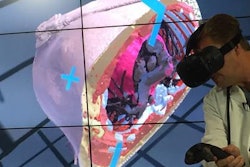
The successful adoption and use of PACS was for many years a much-coveted aspect of radiology. As an early adopter of healthcare IT far ahead of other specialties, radiology was lauded for its innovation and forward thinking.
 Stephen Holloway is principal analyst and company director at Signify Research.
Stephen Holloway is principal analyst and company director at Signify Research.Roll on two decades and things are quite different. The market has boomed with a confusing array of solutions to enable healthcare to go digital. For many radiologists, this has meant dwindling influence and control over radiology IT strategy and implementation, overshadowed by all-encompassing electronic medical record (EMR) implementations, and "enterprise" IT strategy.
Worse still for radiologists, PACS has become a vendor-marketing target to be "integrated," made "patient-centric," and (horror of horrors) "deconstructed." Throw in the onslaught of confusing industry jargon from enterprise imaging vendors -- anyone know the difference between a VNA, CAS, or AICA? -- and then it's no surprise the field has been begrudging in a move away from traditional PACS deployment.
There is some good news, however. While industry may preach that the days of PACS are numbered, there are a number of benefits to the new era of enterprise imaging.
Less deconstructed, more reintegrated
First of all, let's simplify the argument. The core functions and capabilities of PACS and RIS are not going away. Instead, they are just being reintegrated into larger health IT solutions that can be used across the hospital. So this doesn't mean they will become redundant or overlooked -- in fact, they will become more integrated, accessible, and efficient.
Here's a view of how the core functionality of PACS is going to be integrated into wider healthcare IT networks, based on technology and capability that already are available today:
- Archiving and image storage will increasingly be moved into central clinical content storage repositories. This means better economies of scale, more intelligent lifecycle management, simpler and faster migration, interchange of information (no more painful year-long migrations), and a good step toward a single patient identifier -- the holy grail! Moreover, it will increasingly allow radiologists more access to past provider patient history and a multitude of other diagnostically relevant patient data.
- Image viewing will shift away from "PACS-only" workstations and move to "application" neutral viewers. These will not only allow seamless image access and manipulation from the archive, but also enable viewing nonimage content from the patient record within a single window (radiology worklist and workflow included).
- Workflow is also becoming smarter, more automated, and more intelligent. As the majority of clinical content management IT solutions have evolved from an imaging focus (vendor neutral archiving, etc.), radiology worklist integration is quickly becoming the industry standard as well, not to mention the ability to integrate dose-management software, modality utilization, and scheduling analytics.
Not every vendor solution and implementation fits this structure today admittedly. There remain teething problems with proprietary standards, customer protectionism, and interoperability, not to mention data security. However, the technology to achieve the above structure and integration does exist and already is being implemented.
Oceans apart in readiness for enterprise health IT
From a geographic perspective, the push for "deconstruction" and enterprise clinical content management has been driven from across the Atlantic in the U.S., far more than Europe.
The reason? The scale of U.S. hospital and health provider networks has grown massively in the last decade, a result of legislation, rapid adoption of EMR, and the spiraling costs of health data storage. Connecting multiple departmental specialty IT systems consequently became too complex and costly for large health providers.
With stern financial penalties for noncompliance in the U.S. forcing uptake of enterprise-wide IT solutions, PACS and imaging IT was increasingly wrapped up in all-encompassing central IT decision-making. In many instances, this meant radiologists had to put up with a less-preferred PACS or vendor, resulting in grumbling from the reading room.
In contrast, Europe has remained far less exposed to large-scale enterprise overhaul of IT systems. In the majority of Western European markets (excluding Denmark, Finland, and some regional initiatives), EMR adoption has occurred more slowly (or not at all), and PACS and RIS systems have remained in the control of radiologists.
Lucky us, you might think. Or is that indeed the case?
Radiologists' control of PACS might make sense in the short to midterm, yet with the growing focus on integrated care, the interoperability of patient information and health content is vital, imaging included. Thus, the broader digitalization of healthcare and growing enterprise focus of healthcare IT is somewhat inevitable. For a European market generally more entrenched in a smaller-scale, clinical approach to IT implementation, this change could be frustrating. However, there are longer-term benefits too.
The big picture ...
The rapid formation of detailed, well-structured clinical repositories, along with independent clinical archives (ICAs), and clinical enterprise content management (ECM) solutions, is an excellent enabler. Once formed, central clinical repositories will allow better access to diagnostically relevant non-DICOM content that was previously unavailable (as it was stored in siloed IT systems or in dusty paper file archives). Combined with standardized data from EMRs and viewed with an application-neutral viewer, access to complete longitudinal record of patient history and data will be possible.
Greater access also offers more opportunity for collaborative diagnosis outside of the reading room. This means radiologists will be more actively involved in multispecialty diagnoses, furthering the importance of radiology in patient care and ultimately improving the overall quality of care.
Over time, the control and decision-making for workflow tools, viewer interfaces, and diagnostic tools will also return to the experts: radiologists themselves. Advances in IT technology already allow software applications to be more interchangeable and accessible. Also, a clear market divide is forming in healthcare IT provision, between IT software platforms and IT application specialty. Platforms will (in principle) form the necessary foundation and back-end interoperability for any best-of-breed software application to be integrated, thus a radiologist could again control which applications and tools they use at a click of a button. Just think of a medically-certified Apple AppStore for radiology advanced visualization tools, as a service.
And the even bigger picture ...
Finally, and most contentiously, connecting together the vast and rapidly expanding stores of medical imaging data and other clinical content could offer a multitude of opportunities for new diagnostic discoveries. Research on the use of artificial intelligence algorithms and big data analytics to improve diagnosis are becoming a reality due to the growing availability of well-structured and accessible data.
Major challenges in this field are yet to be overcome -- most prominently questions over data ownership, patient data security, its integration into the diagnostic process, and ultimately its role in combination with clinical staff -- but this is an exciting opportunity for the diagnostic radiology field.
While it's quite clear that in reality the everyday use and implementation of this emerging field is a long way off, it will go no further unless imaging and other clinical data is stored in a centralized, open-source, standards-based IT platform with stringent security controls and authorization.
So, next time an enterprise IT vendor asks you at a tradeshow if you want to "deconstruct your PACS, "interface your workflow," "free your data" (an industry favorite), and "enable enterprise interoperability," it might be worth sticking around.
Stephen Holloway is principal analyst and company director at Signify Research (www.signifyresearch.net), a health tech, market-intelligence firm based in Cranfield, U.K.
The comments and observations expressed herein do not necessarily reflect the opinions of AuntMinnieEurope.com, nor should they be construed as an endorsement or admonishment of any particular vendor, analyst, industry consultant, or consulting group.



















